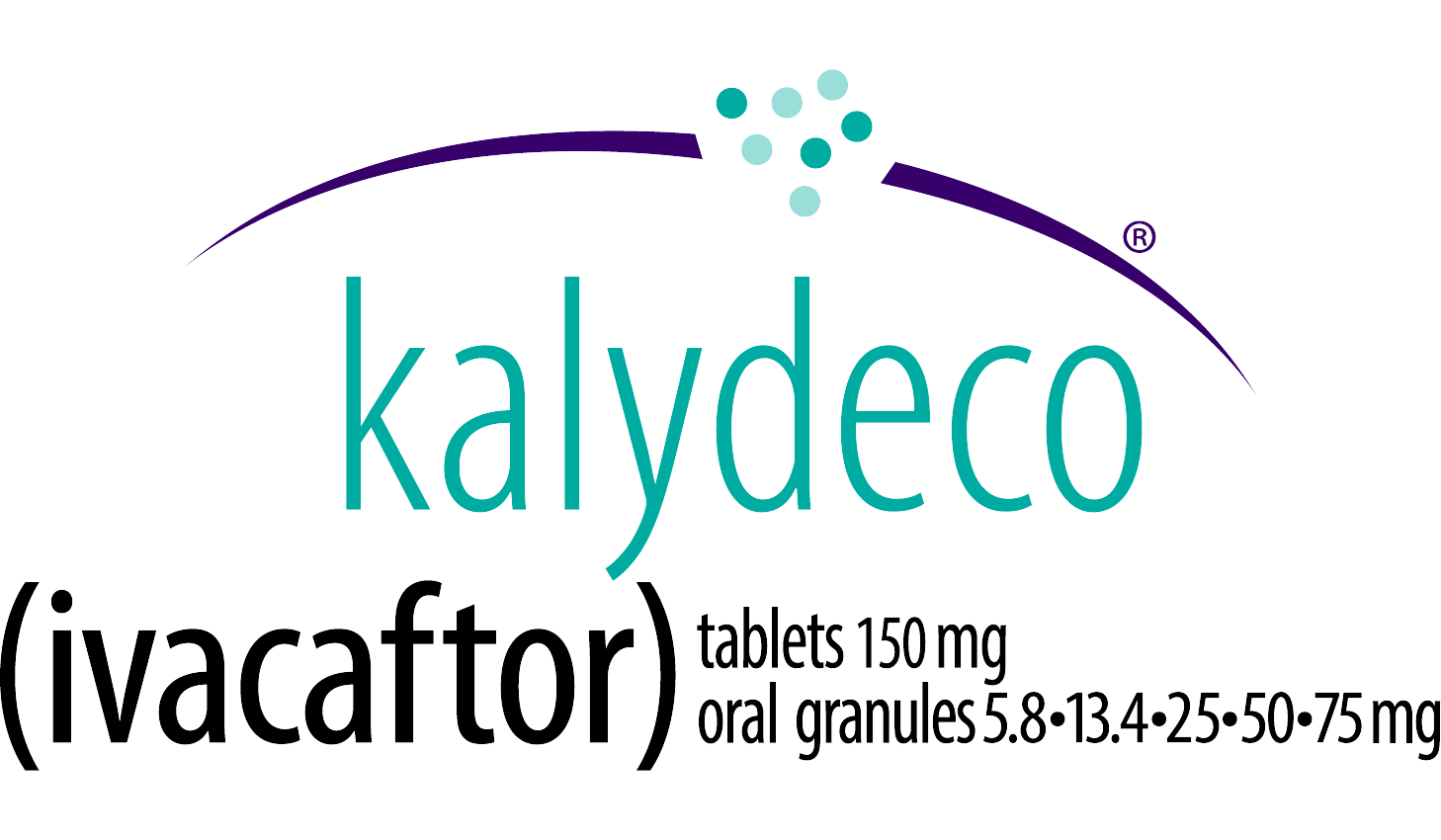Dosing and Administration for KALYDECO® (ivacaftor)1
Dosing Information
| Dosage Forms1 | Recommended Dose |
|---|---|
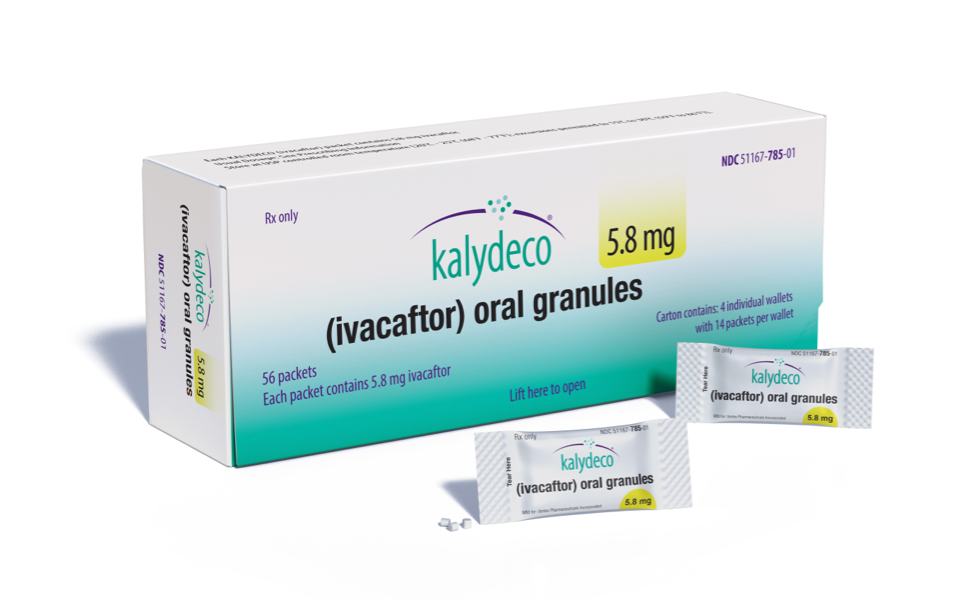
5.8 mg Oral Granules Not actual size. |
For pediatric patients age 1 to <2 months (≥3 kg)a
|
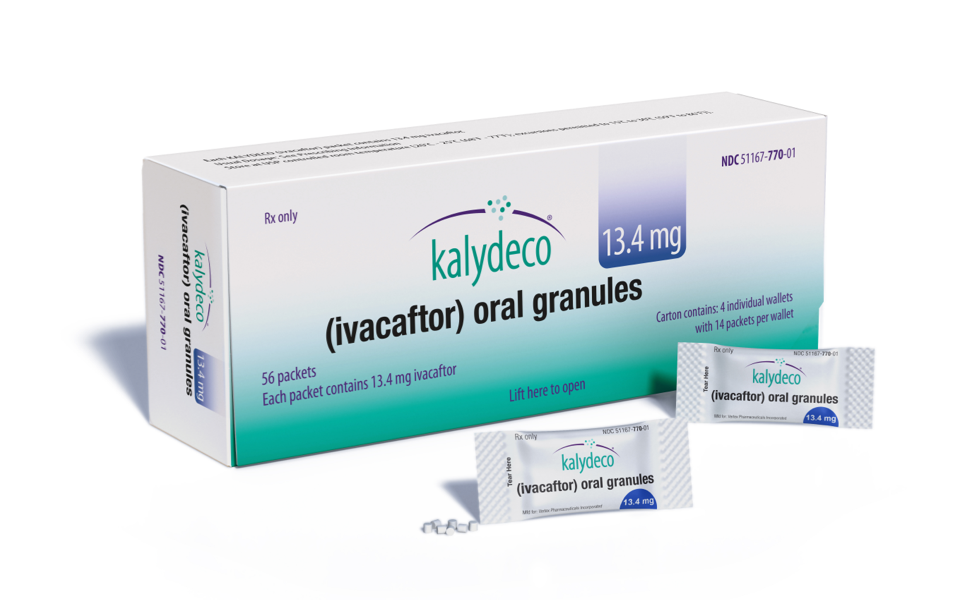
13.4 mg Oral Granules Not actual size. |
For pediatric patients age 2 to <4 months (≥3 kg)a
|
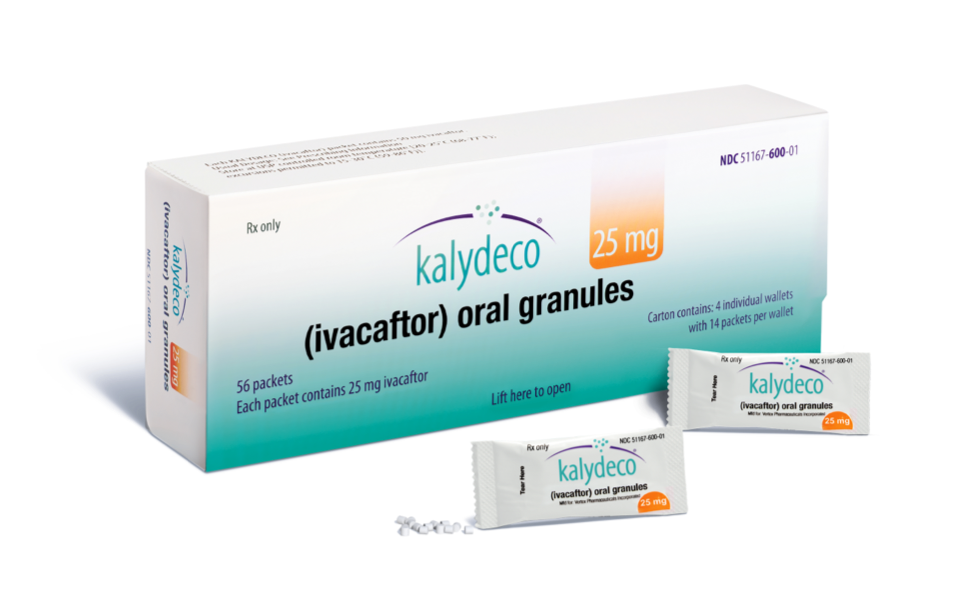
25 mg Oral Granules Not actual size. |
For pediatric patients age 4 to <6 months (≥5 kg)a
For pediatric patients age 6 months to <6 years (5 kg to <7 kg)b
|
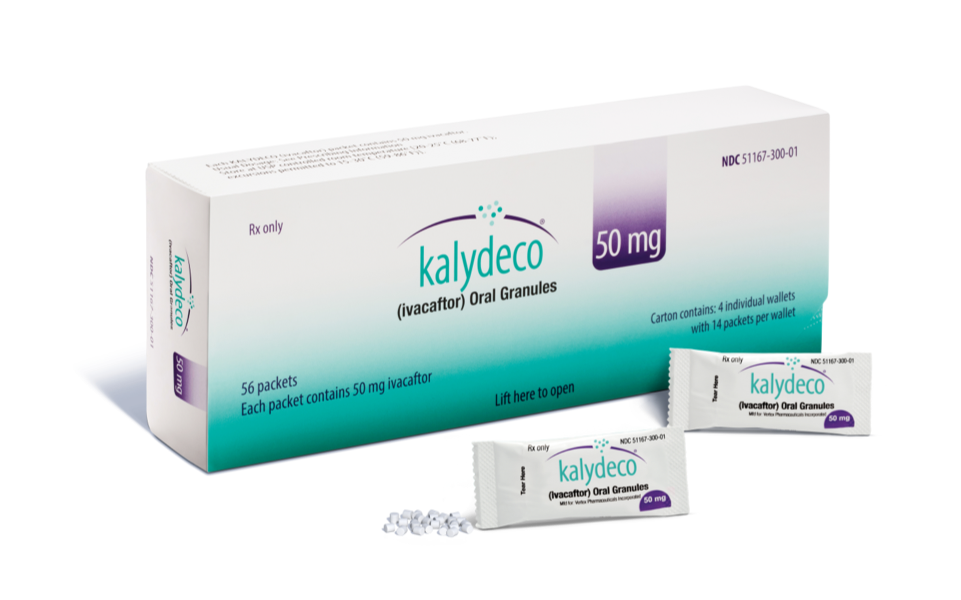
50 mg Oral Granules Not actual size. |
For pediatric patients age 6 months to <6 years (7 kg to <14 kg)c
|
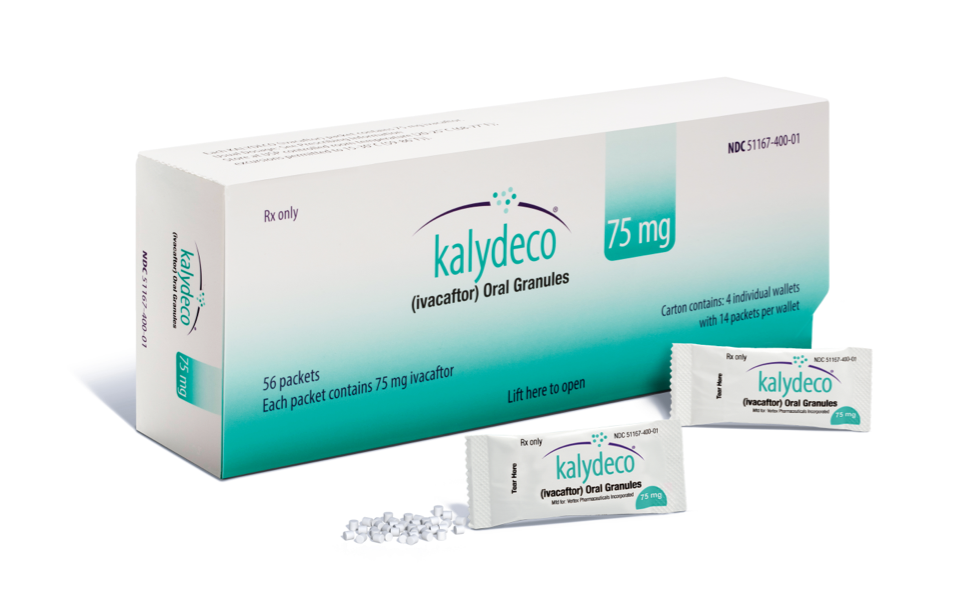
75 mg Oral Granules Not actual size. |
For pediatric patients age 6 months to <6 years (≥14 kg)d
|
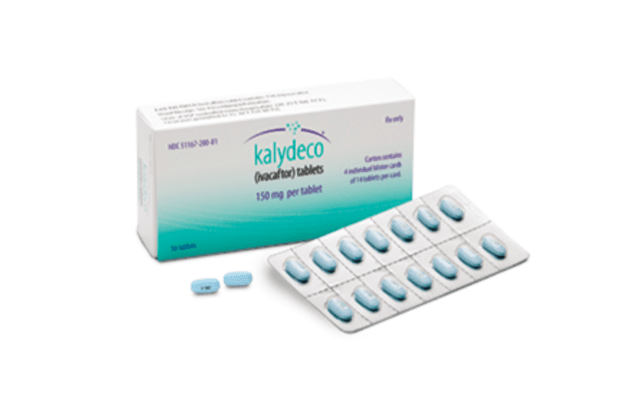
150 mg Tablets Not actual size. |
For patients age 6 years and older
|
|
KALYDECO oral granules and tablets should be taken with fat-containing food |
|
| Dosage Forms1 |
|---|
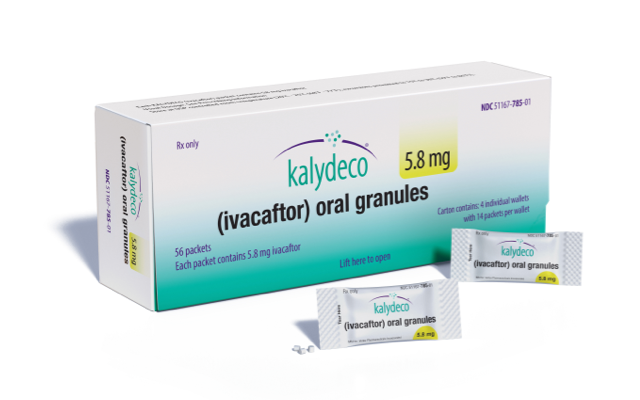
5.8 mg Oral Granules Not actual size. |
| Recommended Dose |
|
For pediatric patients age 1 to <2 months (≥3 kg)a
|
| Dosage Forms1 |
|---|
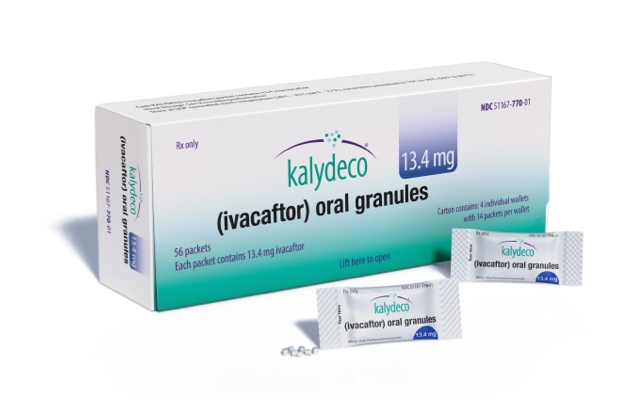
13.4 mg Oral Granules Not actual size. |
| Recommended Dose |
|
For pediatric patients age 2 to <4 months (≥3 kg)a
|
| Dosage Forms1 |
|---|
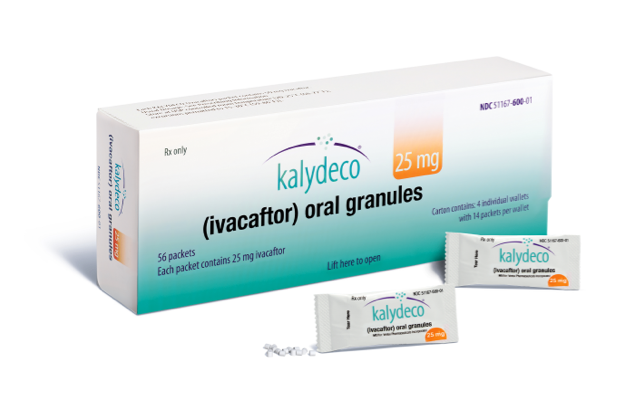
25 mg Oral Granules Not actual size. |
| Recommended Dose |
|
For pediatric patients age 4 to <6 months (≥5 kg)a
For pediatric patients age 6 months to <6 years (5 kg to <7 kg)b
|
| Dosage Forms1 |
|---|
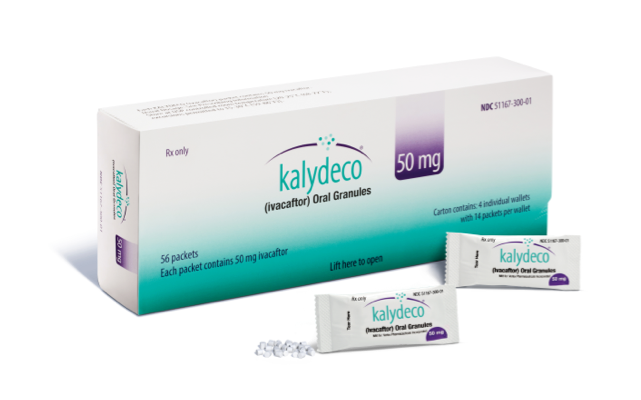
50 mg Oral Granules Not actual size. |
| Recommended Dose |
|
For pediatric patients age 6 months to <6 years (7 kg to <14 kg)c
|
| Dosage Forms1 |
|---|
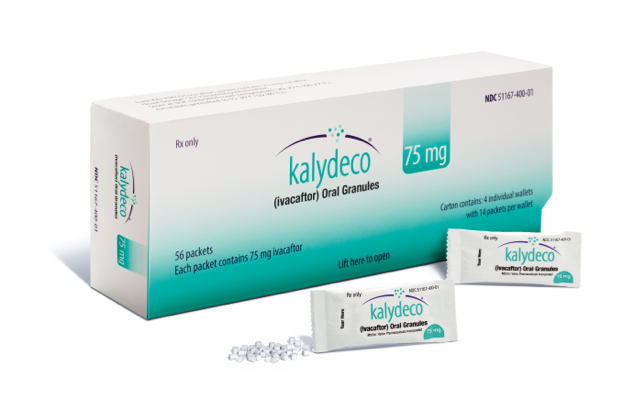
75 mg Oral Granules Not actual size. |
| Recommended Dose |
|
For pediatric patients age 6 months to <6 years (≥14 kg)d
|
| Dosage Forms1 |
|---|

150 mg Tablets Not actual size. |
| Recommended Dose |
|
For patients age 6 years and older
|
|
KALYDECO oral granules and tablets should be taken with fat-containing food |
a≥3 kg ≈ ≥7 lb
b5 kg to <7 kg ≈ 11 to <15 lb
c7 kg to <14 kg ≈ 15 to <31 lb
d≥14 kg ≈ ≥ 31 lb
Patients should continue taking all of their prescribed CF therapies with KALYDECO1
- The safety and efficacy of KALYDECO for pediatric patients <1 month has not been established. The use of KALYDECO in children <1 month is not recommended1
- Use of KALYDECO in pediatric patients aged 1 to <6 months born at a gestational age <37 weeks has not been evaluated
- KALYDECO is not recommended for use in children aged 1 month to <6 months with any level of hepatic impairment and/or taking concomitant moderate or strong CYP3A inhibitors
Dosage Adjustments1
| KALYDECO DOSAGE ADJUSTMENTS1 | |
|---|---|
| DOSAGE ADJUSTMENTS FOR PATIENTS AGE 1 TO <6 MONTHS | DOSE AND ADMINISTRATION FREQUENCY |
| HEPATIC IMPAIRMENT | |
| Any impairment | Use is not recommended |
| CYP3A INHIBITORS | |
| Co-administration with strong or moderate CYP3A inhibitorse,f | Concomitant use not recommended |
| DOSAGE ADJUSTMENTS FOR PATIENTS AGE ≥6 MONTHS | |
| HEPATIC IMPAIRMENT | |
| Severe impairment (Child-Pugh Class C) | One dose once daily, or less frequentlyg |
| Moderate impairment (Child-Pugh Class B) | One dose once dailyg |
| Mild impairment (Child-Pugh Class A) | No dose adjustment required |
| CYP3A | |
| Co-administration with strong CYP3A inhibitorse | One dose twice a weekg |
| Co-administration with moderate CYP3A inhibitorsf | One dose once dailyg |
| KALYDECO DOSAGE ADJUSTMENTS1 | |
|---|---|
| DOSAGE ADJUSTMENTS FOR PATIENTS AGE 1 TO <6 MONTHS | DOSE AND ADMINISTRATION FREQUENCY |
| HEPATIC IMPAIRMENT | |
| Any impairment | Use is not recommended |
| CYP3A INHIBITORS | |
| Co-administration with strong or moderate CYP3A inhibitorse,f | Concomitant use not recommended |
| DOSAGE ADJUSTMENTS FOR PATIENTS AGE ≥6 MONTHS | |
| HEPATIC IMPAIRMENT | |
| Severe impairment (Child-Pugh Class C) | One dose once daily, or less frequentlyg |
| Moderate impairment (Child-Pugh Class B) | One dose once dailyg |
| Mild impairment (Child-Pugh Class A) | No dose adjustment required |
| CYP3A | |
| Co-administration with strong CYP3A inhibitorse | One dose twice a weekg |
| Co-administration with moderate CYP3A inhibitorsf | One dose once dailyg |
eUse of KALYDECO with a strong CYP3A inhibitor significantly increased ivacaftor exposure. Examples include ketoconazole, itraconazole, posaconazole, voriconazole, telithromycin, and clarithromycin.1
fUse of KALYDECO with a moderate CYP3A inhibitor increased ivacaftor exposure. Examples include fluconazole and erythromycin. Avoid food and drinks that contain grapefruit, as these may affect the amount of KALYDECO in the body.1
Use of KALYDECO with strong CYP3A inducers significantly decreases the exposure of ivacaftor. Co-administration of KALYDECO with strong CYP3A inducers, such as rifampin, rifabutin, phenobarbital, carbamazepine, phenytoin, and St. John’s wort is not recommended.1
gOne dose is equal to one tablet or one packet of oral granules.1
Missed dose of oral granules or tablets1
- If ≤6 hours have passed: Advise patient to take the dose with fat-containing food as soon as possible
- If >6 hours have passed: Advise patient to skip that dose and resume the normal schedule for the following dose. A double dose should not be taken to make up for the forgotten dose
Use in Specific Populations
Pregnancy1
There are limited and incomplete human data from clinical trials and post-marketing reports on use of KALYDECO in pregnant women. In animal reproduction studies, oral administration of ivacaftor to pregnant rats and rabbits during organogenesis demonstrated no teratogenicity or adverse effects on fetal development at doses that produced maternal exposures up to approximately 5 (rats) and 11 (rabbits) times the exposure at the maximum recommended human dose (MRHD).
Lactation1
There is no information regarding the presence of ivacaftor in human milk, the effects on the breastfed infant, or the effects on milk production. Ivacaftor is excreted into the milk of lactating rats. The developmental and health benefits of breastfeeding should be considered along with the mother's clinical need for KALYDECO, and any potential effects on the breastfed child from KALYDECO or from the underlying maternal condition.
For more information on pregnancy and lactation, please see full Prescribing Information.
Pediatric use1
The safety and effectiveness of KALYDECO for the treatment of CF have been established in pediatric patients 1 months to 17 years of age who have at least one mutation in the CFTR gene that is responsive to ivacaftor potentiation based on clinical and/or in vitro assay data.
Placebo-controlled clinical trials included the following CF patients:
- 6 to 17 years of age with a G551D, G1244E, G1349D, G178R, G551S, S1251N, S1255P, S549N, S549R, R117H mutation in the CFTR gene
- 12 to 17 years of age who are heterozygous for the F508del mutation and a second mutation predicted to be responsive to ivacaftor
The effectiveness of KALYDECO in children aged 2 to less than 6 years was extrapolated from efficacy in patients 6 years of age and older with support from population pharmacokinetic analyses showing similar drug exposure levels in adults and children 2 to less than 6 years of age. The safety of KALYDECO in children 2 years to less than 6 years of age was derived from a 24-week, open-label, clinical trial in 34 patients aged 2 to less than 6 years (mean age 3 years) administered either 50 mg or 75 mg of ivacaftor oral granules twice daily (Trial 6). The type and frequency of adverse reactions in this trial were similar to those in patients 6 years and older. Transaminase elevations were more common in patients who had abnormal transaminases at baseline.
The effectiveness of KALYDECO in patients aged 1 month to less than 24 months was extrapolated from patients 6 years of age and older with support from population pharmacokinetic analyses showing similar drug exposure levels in adults and children 1 month to less than 24 months of age. Safety of KALYDECO in this population was derived from a cohort of 7 patients aged 1 month to less than 4 months (mean age 1.9 months at baseline), a cohort of 6 patients aged 4 months to less than 6 months (mean age 4.5 months at baseline), a cohort of 11 patients aged 6 months to less than 12 months (mean age 9.0 months at baseline), and a cohort of 19 patients aged 12 months to less than 24 months (mean age 15.2 months at baseline) in a 24-week, open-label clinical study (Trial 8). The safety profile of patients in this trial is similar to that observed in patients 2 years and older.
The safety and effectiveness of KALYDECO in patients with CF younger than 1 month have not been established. The use of KALYDECO in children under the age of 1 month is not recommended.
Geriatric use1
CF is largely a disease of children and young adults. Clinical trials of KALYDECO did not include sufficient numbers of patients 65 years of age and over to determine whether they respond differently from younger patients.
Hepatic impairment1
No dose adjustment is necessary for patients aged 6 months or older with mild hepatic impairment (Child-Pugh Class A).
A reduced dose is recommended in patients aged 6 months or older patients with moderate (Child-Pugh Class B).
Studies have not been conducted in patients with severe hepatic impairment (Child‑Pugh Class C), but exposure is expected to be higher than in patients with moderate hepatic impairment. Therefore, use with caution at a reduced dose, in patients aged 6 months or older with severe hepatic impairment after weighing the risks and benefits of treatment.
Due to variability in maturation of cytochrome (CYP) enzymes involved in ivacaftor metabolism, treatment with KALYDECO is not recommended in patients aged 1 month to less than 6 months with any level of hepatic impairment.
Please see dose adjustments for moderate and severe hepatic impairment above
Renal impairment1
KALYDECO has not been studied in patients with mild, moderate, or severe renal impairment or in patients with end‑stage renal disease. No dose adjustment is necessary for patients with mild to moderate renal impairment; however, caution is recommended while using KALYDECO in patients with severe renal impairment (creatinine clearance ≤30 mL/min) or end‑stage renal disease.
How to administer KALYDECO oral granules: 3 steps1
1. PREPARATION1
- Caregiver should hold the packet with the cut line on top, shake the packet gently to settle the granules, and tear or cut the packet open along the cut line
- Caregiver should mix all granules into 1 teaspoon (5 mL) of age-appropriate soft food or liquid
- Food or liquid should be at or below room temperature

EXAMPLES OF SOFT FOODS AND LIQUIDS TO MIX WITH KALYDECO GRANULES FOR CHILDREN:
- Breast milk or infant formula
- Puréed vegetables or fruits
- Applesauce
- Milk or yogurt
- Water
- Juice
2. ADMINISTRATION1
- After mixing, caregiver should give within 1 hour
- Caregiver should make sure the child finishes the dose completely
3. GIVE WITH FAT-CONTAINING FOOD1
- Food that contains fat must be taken just before or just after the oral granules dose
EXAMPLES OF FAT-CONTAINING FOODS FOR CHILDREN:
- Breast milk or infant formula
- Cheesea
- Whole milk
- Yogurta
- Butter
- Eggs
- Cheese pizzaa
- Peanut butter
Keep your patients’ age in mind when recommending fat-containing food to caregivers.
aBe sure that cheeses and yogurts are made with whole milk.1
Food and drinks containing grapefruit may increase exposure
of ivacaftor and should be avoided during treatment with KALYDECO1
IMPORTANT SAFETY INFORMATION
WARNINGS AND PRECAUTIONS
Transaminase (ALT or AST) Elevations
- Elevated transaminases have been reported in patients with CF receiving KALYDECO. Transaminase elevations were more common in patients with a history of transaminase elevations or in patients who had abnormal transaminases at baseline. ALT and AST should be assessed prior to initiating KALYDECO, every 3 months during the first year of treatment, and annually thereafter. For patients with a history of transaminase elevations, consider more frequent monitoring of liver function tests
- Patients who develop increased transaminase levels should be closely monitored until the abnormalities resolve. Dosing should be interrupted in patients with ALT or AST of greater than 5 times the upper limit of normal (ULN). Following resolution of transaminase elevations, consider the benefits and risks of resuming KALYDECO
INDICATIONS AND USAGE
KALYDECO is indicated for the treatment of cystic fibrosis (CF) in patients age 1 month and older who have at least one mutation in the CFTR gene that is responsive to ivacaftor potentiation based on clinical and/or in vitro assay data.
If the patient's genotype is unknown, an FDA-cleared CF mutation test should be used to detect the presence of a CFTR mutation followed by verification with bi-directional sequencing when recommended by the mutation test instructions for use.
INDICATIONS AND USAGE
KALYDECO is indicated for the treatment of cystic fibrosis (CF) in patients age 1 month and older who have at least one mutation in the CFTR gene that is responsive to ivacaftor potentiation based on clinical and/or in vitro assay data.
If the patient's genotype is unknown, an FDA-cleared CF mutation test should be used to detect the presence of a CFTR mutation followed by verification with bi-directional sequencing when recommended by the mutation test instructions for use.
IMPORTANT SAFETY INFORMATION
WARNINGS AND PRECAUTIONS
Transaminase (ALT or AST) Elevations
- Elevated transaminases have been reported in patients with CF receiving KALYDECO. Transaminase elevations were more common in patients with a history of transaminase elevations or in patients who had abnormal transaminases at baseline. ALT and AST should be assessed prior to initiating KALYDECO, every 3 months during the first year of treatment, and annually thereafter. For patients with a history of transaminase elevations, consider more frequent monitoring of liver function tests
- Patients who develop increased transaminase levels should be closely monitored until the abnormalities resolve. Dosing should be interrupted in patients with ALT or AST of greater than 5 times the upper limit of normal (ULN). Following resolution of transaminase elevations, consider the benefits and risks of resuming KALYDECO
Hypersensitivity Reactions, Including Anaphylaxis
- Hypersensitivity reactions, including cases of anaphylaxis, have been reported in the postmarketing setting. If signs or symptoms of serious hypersensitivity reactions develop during treatment, discontinue KALYDECO and institute appropriate therapy. Consider the benefits and risks for the individual patient to determine whether to resume treatment with KALYDECO
Concomitant Use With CYP3A Inducers
- Use of KALYDECO with strong CYP3A inducers, such as rifampin, substantially decreases the exposure of ivacaftor, which may reduce the therapeutic effectiveness of KALYDECO. Co-administration of KALYDECO with strong CYP3A inducers, such as rifampin, rifabutin, phenobarbital, carbamazepine, phenytoin, and St. John's wort is not recommended
Cataracts
- Cases of non-congenital lens opacities/cataracts have been reported in pediatric patients treated with KALYDECO. Baseline and follow-up ophthalmological examinations are recommended in pediatric patients initiating treatment with KALYDECO
ADVERSE REACTIONS
Serious Adverse Reactions
- Serious adverse reactions, whether considered drug-related or not by the investigators, which occurred more frequently in patients treated with KALYDECO included abdominal pain, increased hepatic enzymes, and hypoglycemia
Most Common Adverse Reactions
- The most common adverse reactions in the 221 patients treated with KALYDECO were headache (17%), upper respiratory tract infection (16%), nasal congestion (16%), nausea (10%), rash (10%), rhinitis (6%), dizziness (5%), arthralgia (5%), and bacteria in sputum (5%)
- The safety profile for the CF patients enrolled in clinical trials (Trials 3-8) was similar to that observed in the 48-week, placebo-controlled trials (Trials 1 and 2)
USE IN SPECIFIC POPULATIONS
Pediatric Use
- The safety and effectiveness of KALYDECO in patients with CF younger than 1 month of age have not been established. The use of KALYDECO in children under the age of 1 month is not recommended
- Use of KALYDECO in patients aged 1 to less than 6 months born at a gestational age less than 37 weeks has not been evaluated
Click here to access full Prescribing Information.
Reference:
1. KALYDECO [prescribing information]. Boston, MA: Vertex Pharmaceuticals Incorporated; August 2023.
